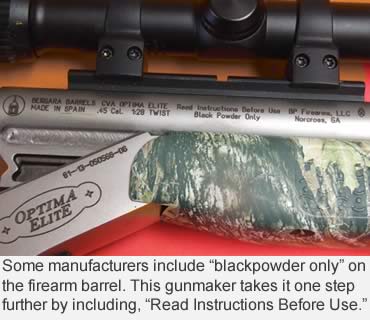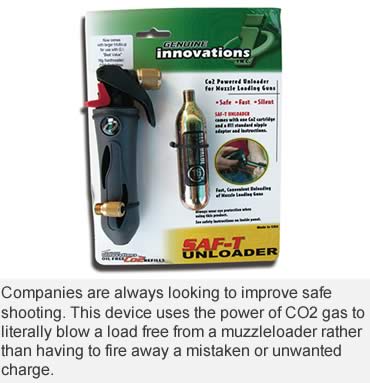Hunting with blackpowder firearms isn’t inherently dangerous, but a little safety savvy is required.
Accidents always happen to “the other guy.” Or do they? Sometimes that other guy is one of us. Take the man who was killed by a grizzly not far from my camp. Odds of a bear attacking him were less than being struck by lightning. However, this fact was no solace to his family looking at his empty chair the next Christmas.
Smokeless Powder — This one goes to the top, because regardless of repeated warnings, someone will decide to drop a charge of smokeless down the muzzle of a frontloader intended for blackpowder only. The result can be devastating, including a complete failure at the breech with fragmentation.
A blackpowder cannon once exploded when a young man mistakenly loaded it with smokeless powder. He was badly injured.
Use only blackpowder or approved blackpowder substitute in your muzzleloader.
Note: The Savage 10 ML II muzzleloader, designed to handle careful (and rather light) loads of smokeless powder, is an exception to this rule.
Double Load — Jim insisted that he loaded his rifle normally and could not understand why it blew to pieces when he pulled the trigger. I submit that the shooter, admitting that he left the rifle loaded the previous day, simply forgot and loaded it again. Strong evidence of bullet wash and a bulge convinced me that a second load was run down the bore and not fully seated.
The devastation could never have occurred with the standard approved load that Jim claimed destroyed his rifle, because it lacked the energy to cause such destruction.
Be certain that your muzzleloader receives one and only one powder/bullet load.
Bore Obstruction — Many a fine gun has been blasted into the firearm graveyard with a bore obstruction, and not only muzzleloaders. A shooter once forgot to remove the boresighting device from the muzzle of his modern rifle. The result was a barrel that looked like a peeled banana. The picture was circulated on the Internet, a graphic warning.
If in doubt, run the ramrod or loading rod home to prove that nothing is lodged between the bullet and the muzzle.
 Loose Breechplug — One shooter’s breechplug dislodged and flew straight back at him when he pulled the trigger of his muzzleloader. Clearly, as proved by clean male and female threads, the breechplug was never properly seated in the first place. A muzzleloader essentially is a strong metal tube with one closed end. Fail to secure that end, and Newton’s Third Law of Motion, “Every action has an opposite and equal reaction,” takes over.
Loose Breechplug — One shooter’s breechplug dislodged and flew straight back at him when he pulled the trigger of his muzzleloader. Clearly, as proved by clean male and female threads, the breechplug was never properly seated in the first place. A muzzleloader essentially is a strong metal tube with one closed end. Fail to secure that end, and Newton’s Third Law of Motion, “Every action has an opposite and equal reaction,” takes over.
A loose breechplug is simply a bullet aiming the wrong way. Take the time to fully seat a breechplug following a bore cleaning.
Misinformation — The grand opening of a sporting goods store was a gala event. Along with a host of other invitees, I attended it for a book signing. One chap from a prominent gun company stood nearby, giving free advice to sportsmen. His information was worth exactly what he charged. “Now,” he said with puffed authority, “if you shoot a conical bullet, you can load as much powder as you like. But with a round ball, you have to watch it.” Wrong! Muzzleloaders are powder- and charge-specific, regardless of the bullet type.
Consider the source of information. Seek a second opinion. Do a little research.
Short Start — No one knows exactly why, but leaving air space between a powder charge and an unseated projectile can cause a bulge in the barrel, and, in some cases, a rupture. A prominent laboratory “proved” that, although warnings about short-starts go back to at least the 18th century, the condition is not harmful. Their tests, however, were flawed, including failure to orient the powder charge, especially with regard to the powder lying in a trough along the bottom of the bore.
Ezekiel Baker wrote in his 1835 book dedicated to King George, “if not the ball be rammed close to the powder, the intervening air will frequently cause the barrel to burst.”
Always make sure the bullet is firmly seated on the powder charge.
 Overload — One old wives’ tale was the notion that “you can’t overload blackpowder. Excess just blows away.” Attending this erroneous idea was the promise that blackpowder could never achieve more than 25,000 pounds-per-square-inch pressure.
Overload — One old wives’ tale was the notion that “you can’t overload blackpowder. Excess just blows away.” Attending this erroneous idea was the promise that blackpowder could never achieve more than 25,000 pounds-per-square-inch pressure.
Loading beyond the maximum charge/bullet allowed by the manufacturer is not only risky, but also can be counterproductive, considering the law of diminishing returns. Putting more powder often produces more recoil but not additional velocity.
A hunter once prepared a huge overload in a muzzleloading shotgun, taking up a full third of the bore. The gun actually held, but the barrel/receiver blew out of the stock, crushing the man’s orbital bone.
Load strong for big game, but within the limits set by the manufacturer.
Cigarette/Pipe/Cigar Ash — Years ago, there was a country song with the lyrics “Smoke, smoke, smoke that cigarette.” Cigarettes, pipes and cigars produce a hot ash and have no place around gunpowder, especially blackpowder, which has a low flash point or ignition temperature.
Three benches down from me, a roaring flame leaped skyward. Luckily, the smoker flicked his cigarette ash at an arm’s length rather than dropping it straight down into the open can of powder. To his good fortune, the container was a plastic bottle with a wide mouth. The result was not an explosion, but a Roman candle of grand performance. Burns were minor. The experience, however, was major.
Smoking around gunpowder is asking for trouble. Don’t do it. Remember also to screw the cap back on a powder container after use.
 Improper Maintenance — Allowing a fired bore to go unattended, especially in areas of high humidity, causes ferric oxide damage — rust, in other words. One of the problems of bore rust is bullet seating. A rough bore may retard seating a bullet on the powder, leading to a short start.
Improper Maintenance — Allowing a fired bore to go unattended, especially in areas of high humidity, causes ferric oxide damage — rust, in other words. One of the problems of bore rust is bullet seating. A rough bore may retard seating a bullet on the powder, leading to a short start.
A man charged a company with negligence when the nipple of his rifle blew back into his face. Inspection proved that the nipple had been fully seated. It completely stripped the threads in the nipple seat. The rifle’s bore was packed with fouling. The shooter admitted that it had been many shots since he scrubbed the bore or the nipple seat.
The smart airplane pilot does a pre-flight check before taking off in his bird. The smart shooter does the same with his firearm.
Maintenance goes to powder as well as guns. Store all powders in a dry place away from any flame source.
Percussion Caps and Primers — Johnny Curious decided to see what would happen if he placed a few percussion caps on the electric stove burner. He turned on the stove and found out. One exploded cap flew right into his eye (luckily, not the pupil). The name is fictitious; the event is not.
Percussion caps and primers are best stored in their original containers, special cap boxes or cappers until properly installed for ignition.
Impact-Sensitive Powder — The warning about putting one’s full weight on a ramrod or loading rod is not a bad idea, although no case of blackpowder or any proper substitute igniting by rod pressure has ever come to my attention. Any powder has the potential to ignite from a terrific blow, as with a sledge hammer.
Don’t put your full weight on the ramrod or loading rod — just in case.
That Sneaky Old Latent Spark — There is no proven case of a latent spark setting off a powder charge in a breech that I know of, and I have looked. Every blackpowder hunter knows that after taking a shot at game, you reload pronto. I certainly do. One chap declared that after taking a poke at a buck, he quickly reloaded his rifle and it “went off” from leftover fire downbore, driving the ramrod into his body.
When questioned further, he admitted that he was very excited, spilled some powder from the muzzle to the ground, poured in more and was not really sure if the rifle was capped.
The real culprit here was muzzle direction. Capt. Meriwether Lewis of the 1803 Lewis & Clark expedition was accidentally shot by a nearsighted fiddle player returning from a romp for elk. With the muzzle pointed in a safe direction, even if the gun goes off, no one gets hurt.
So the real warning here is not about latent spark. It’s about the simplest rule in shooting: Do not point the muzzle at anything you don’t want to put a hole in, including yourself.
This article was published in the September 2008 edition of Buckmasters GunHunter Magazine. Subscribe today to have GunHunter delivered to your home.